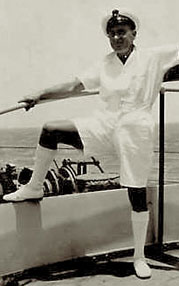CONTENTS
- Background: PQ17
- Biography: Jack Bowman
- HMS La Malouine
- Galleries:
- PQ17: Merchant Ships
- PQ17: Close Escort
PQ17 Diary
Jack Bowman

Engine Room Artificer (ERA) HMS La Malouine, 1940-44 (c) Bowman family archive.
Background | 1 of 3
In June 1941, after German forces had invaded the USSR, Great Britain found herself in alliance with the Soviet Union. Despite being vehemently opposed to the communist system Churchill declared on 22 June:
The Russian danger is...our danger, and the danger of the United States,.......we shall give whatever help we can to Russia.
This offer came despite the United Kingdoms own severe shortage of war mat?riel.
Churchill quickly despatched an Admiralty team to investigate the possibility of sending a Royal Navy presence to the Arctic. Their report was not positive, recommending that the UK presence should be limited to a couple of submarines. The Navy reasoned that sending surface forces would leave them open to unacceptable risk due to the close proximity of Luftwaffe units in occupied Norway and the long hours of daylight in arctic latitudes. Churchill however was determined and later stated:
The Russians.....will expect us to run the risk and pay the price.
The decision was made and convoys began, under the outbound code PQ, to Archangel and Murmansk. The first convoy left Britain in August 1941. By 1942, from the 12 convoys and 103 ships that sailed, only one ship had been lost. The Admiralty's fears appeared to have been unjustified. Then in May 1942 Convoy PQ16 lost 5 ships. A precedent was being set.
The Kriegsmarine, in the person of Gross Admiral Erich Raeder, recognised the importance of these Arctic Convoys to Russia. He continued pressing Hitler to allow the deployment of heavy units to northern Norway. Hitler, convinced that the USSR was about to collapse, resisted. However, the German offensive in Russia stalled in late 1941 and America entered the war. This new addition to the Allied cause saw the flow of mat?riel to Russia, via the Arctic route, increase considerably. Raeder was thus able to secure Hitler's permission to transfer heavy units, including Tirpitz, to Norway. These were in place by January 1942.
The threads that were to spell disaster for Convoy PQ17 were drawing themselves together.